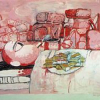Philip Guston

Philip Guston
Philip Guston, born Phillip Goldstein, was a painter and printmaker in the New York School, which included many of the abstract expressionists, such as Jackson Pollock and Willem de Kooning. In the late 1960s Guston helped to lead a transition from abstract expressionism to neo-expressionism in painting, abandoning the so-called "pure abstraction" of abstract expressionism in favor of more cartoonish renderings of various personal symbols and objects...
NationalityAmerican
ProfessionPainter
Date of Birth27 June 1913
CountryUnited States of America
Probably the most potent desire for a painter, an image-maker, is to see it. To see what the mind can think and imagine, to realize it for oneself, through oneself, as concretely as possible.
The painting is not on a surface, but on a plane which is imagined. It moves in a mind. It is not there physically at all. It is an illusion, a piece of magic, so that what you see is not what you see.
I don't know what a painting is; who knows what sets off even the desire to paint? It might be things, thoughts, a memory, sensations, which have nothing to do directly with painting itself. They can come from anything and anywhere.
Lots of artists who paint have the experience to one degree or another... where their thinking doesn't precede their doing... It's a funny thing, what I really hate yet I have to go through with it, is the preparation.
It is possible to make a living thing, not a diagram of what I have been thinking: to posit with paint something living, something that changes each day.
The canvas you are working on modifies the previous ones in an unending, baffling chain which never seems to finish. What sympathy is demanded of the viewer? He is asked to 'see' the future links.
Painting seems like impossibility, with only a sign now and then of its own light.
I'm not interested in painting; I'm not interested in making a picture. Then what the hell am I interested in? I must be interested in this process.
Usually I draw in relation to my painting, what I am working on at the time. On a lucky day a surprising balance of forms and spaces will appear... making itself, the image taking hold. This in turn moves me toward painting - anxious to get to the same place, with the actuality of paint and light.
There comes a point when the paint doesn't feel like paint. I don't know why. Some mysterious thing happens. I think you have all experienced it... What counts is that the paint should really disappear, otherwise it's craft.
All these troubles revolve around the irritable mutual dependence of life and art - with their need and contempt for one another. Of necessity, to create is a temporary state and cannot be possessed...
That's what I mean by something grips in a canvas. The moment that happens you are then sucked into the whole thing. Like some kind of rhythm.
The canvas is a court where the artist is prosecutor, defendant, jury and judge. Art without a trial disappears at a glance.
But you begin to feel as you go on working that unless painting proves its right to exist by being critical and self-judging, it has no reason to exist at all - or is not even possible. The canvas is a court where the artist is prosecutor, defendant, jury and judge. Art without a trial disappears at a glance.